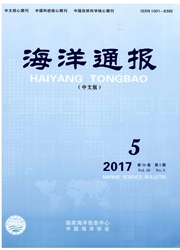

 中文摘要:
中文摘要:
根据2006年5月在长江口及其邻近水域(30°30′N-32°30′N,121°E-123°30′E) 39个测站采集的浮游植物水样,应用Uterm(o)hl方法初步分析研究了该水域浮游植物群集特征,并针对浮游植物优势物种与相关环境因子进行典范对应分析.调查区浮游植物以硅藻和甲藻为主,此外还有少量的金藻、蓝藻和绿藻.浮游植物细胞丰度介于0.76~6123.78 cells/mL之间,平均为397.94 cells/m L.主要优势物种为具齿原甲藻(Prorocentrum dentatum),骨条藻(Skeletonema spp.)和米氏凯伦藻(Karenia mikimotoi),细胞丰度明显高于2006年同航次网样分析结果,具齿原甲藻和米氏凯伦藻水采样品中为优势物种,网样中则较少检出,水采结果甲藻丰度比例远高于硅藻,与网采结果相反.甲藻物种数和丰度比例较往年明显增加,群集结构与其他季节有明显差异.浮游植物细胞丰度在5 m层出现最大值.两个典型断面的浮游植物分布特征受到具齿原甲藻、骨条藻和米氏凯伦藻共同影响.南部水域浮游植物群集多样性程度和物种均一性高于浮游植物密集区.应用典范性对应分析表明春季环境因子中盐度、溶解氧与甲藻相关性较大,硅藻与pH值和营养盐浓度关系更为密切.
 英文摘要:
英文摘要:
Based on the multidisciplinary cruise investigation in the Yangtze River estuary and its adjacent waters in May 2006,the phytoplankton species and their abundance were analyzed by the Uterm(o)hl method.In the meantime,the relationships between the dominant phytoplankton species and environmental factors were explored by Canonical Correspondence Analysis (CCA).The primary phytoplankton groups were diatoms and dinoflagellates.There were also a few species belonging to Chrysophyceae,Chlorophyceae and Cyanophyceae,respectively.The cell abundance of phytoplankton ranged from 0.76 to 6123.78 cells/mL with the average being 397.94 cells/mL.The dominant species were Prorocentrum dentatum,Skeletonema spp.,Karenia mikimotoi.The cell abundance of phytoplankton in water sample was higher than net sample on the cruise.In contrast to the net sample,P.dentatum,and K.mikimotoi.were dominant species,the cell abundance proportion of dinoflagellates was higher than diatoms in water sample.The number of dinoflagellates species and cell abundance increased distinctly.The maximum phytoplankton cell abundance was at 5 m water layer.Section distributions were briefly described by P.dentatum,S.spp.and K.mikimotoi.The Shannon diversity index and Pielou evenness indcx wcrc consistently high in the southern part of the survey area,in contrast to the trend of phytoplankton cell abundance.The CCA showed that the distribution of dinoflagellates was mainly associated with water salinity and dissolved oxygen,while diatoms were mainly affected by pH value and the water nutritive contents.
 同期刊论文项目
同期刊论文项目
 同项目期刊论文
同项目期刊论文
 First record of a large-scale bloom-causing species Nannochloropsis granulata (Monodopsidaceae, Eust
First record of a large-scale bloom-causing species Nannochloropsis granulata (Monodopsidaceae, Eust Top-down control of spring surface phytoplankton blooms by microzooplankton in the Central Yellow Se
Top-down control of spring surface phytoplankton blooms by microzooplankton in the Central Yellow Se Increasing the quality, comparability and accessibility of phytoplankton species composition time-se
Increasing the quality, comparability and accessibility of phytoplankton species composition time-se 期刊信息
期刊信息
